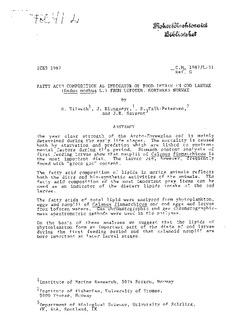Fatty acid composition as indicator of food intake in cod larvae (Gadus morhua L.) from Lofoten, northern Norway
Working paper
Permanent lenke
http://hdl.handle.net/11250/104346Utgivelsesdato
1987Metadata
Vis full innførselSamlinger
Originalversjon
This report is not to be cited without prior reference to the authorsSammendrag
The year class strength of the Arcto-Norwegian cod is mainly
determined during the early life stages. The mortality is caused
both by starvation and predation which are linked to environmental
factors during this period. Stomach content analysis of
first feeding larvae show that nauplii of Calanus finmarchicus is
the most important diet. The larvae are, however, frequently
found with "green gut" content.
The fatty acid composition of lipids in marine animals reflects
both the diets and bio-synthetic activities of the animals. The
fatty acid composition of the most important prey items can be
used as an indicator of the dietary lipids intake of the cod
larvae.
The fatty acids of total lipid were analysed from phytoplankton,
eggs and nauplii of Calanus finmarchicus and cod eggs and larvae
from Lofoten waters. Gas chromatographic and gas chromatographicmass
spectrometric methods were used in the analyses.
On the basis of these analyses we suggest that the lipids of
phytoplankton form an important part of the diets of cod larvae
during the first feeding period and that calanoid nauplii are
more important at later larval stages.
